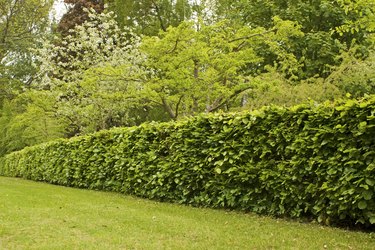
Southwest Florida includes Collier, Hendry, Lee, Glades and Charlotte counties, falling within U.S. Department of Agriculture plant hardiness zones 9b and 10a. Over 60 inches of rain can fall annually, with 60 to 72 percent between June and September. The mean annual average temperature is 74 degrees Fahrenheit, and severe freezes occur about every 20 years. These factors combine into a subtropical to tropical climate where plants can grow vigorously year-round. Many hedge plants are suitable, including native plants.
Shrubs With Colorful Flowers
Video of the Day
Some hedges provide showy flowers as well as a screening function. Glabra firebush (Hamelia patens var. glabra, hardy in USDA zones 8 through 11) blooms year-round with clusters of red, tubular flowers that attract hummingbirds and butterflies. It grows 8 to 12 feet tall and accepts pruning. For spectacular blooms 4 to 8 inches wide, choose a cultivar of tropical hibiscus (Hibiscus rosa-sinensis, hardy in USDA zones 9 through 11). Flowers occur in all colors except blue and black. Characterized by Lee County Extension Service as the most popular Florida shrub, hibiscus is best grown as an informal hedge, reaching 4 to 10 feet tall and 5 to 8 feet wide.
Video of the Day
Shrubs With Showy Fruit
Add fall color to hedges with shrubs that produce ornamental fruit. For a display of red berries that ripen to black and attract songbirds, plant Walter's viburnum (Viburnum obovatum, hardy in USDA zones 8a through 10a). This native shrub grows to about 12 to 15 feet tall, suitable for a formal or informal hedge. In spring, showy clusters of small, white flowers occur at branch ends. Another native with showy berries, wax myrtle (Myrica cerifera, hardy in USDA zones 8a through 11) has waxy, dark-blue berries in clusters along the branches of female plants. Plant mostly females with at least one male bush for pollination.
Shrubs for Shaded Areas
For a hedge in a shaded part of the yard, try wild coffee (Psychotria nervosa, hardy in USDA zones 9 through 12), an evergreen Florida native that grows 6 to 7 feet tall and wide. It grows best in heavy or moderate shade, but tolerates full sun as well. Small white spring flowers are followed by glossy, bright red clusters of berries. Another example of a shrub that does well in full shade but also grows in sun is twinberry, also known as Simpson's stopper (Myrcianthes fragrans, hardy in USDA zones 9b through 11). The oval leaves are fragrant, as are the white flowers that occur throughout the year, which are followed by small red berries.
Shrubs Tolerant of Shearing
For formal gardens, hedges are often kept closely trimmed and sheared. Dwarf yaupon hollies (Ilex vomitoria "Nana," hardy in USDA zones 7 through 10), normally slow-growing to 7 or 10 feet tall, are usually kept sheared to 4- to 6-foot-high hedges. They don't need frequent trimming to maintain shape and size. For an example of a fine-leaved shrub with moderate growth that responds well to shearing, consider Florida privet (Forestieria segregata, hardy in USDA zones 8b through 11). Usually 5 to 10 feet tall, maintain the hedge at any desired height within its growth range. It prefers full sun and well-draining soil.
- Florida Counties Map: Southwest
- South Florida Water Management District: Waterwise South Florida Landscapes
- Southwest Florida Regional Planning Council: Comprehensive Southwest Florida/Charlotte Harbor Climate Change Vulnerability Assessment
- Naples Daily News: Turn Unlikely Plants Into Hedges
- Lee County Southwest Florida: Native Plants for Landscaping
- University of Florida IFAS Extension: Gardening in a Minute: Firebush
- University of Florida IFAS Extension Collier County: Alternative Shrubs for the Ficus Hedge With a Firebush Emphasis
- Missouri Botanical Garden: Hibiscus Rosa-Sinensis
- University of Florida IFAS Extension: Hendry County Horticulture Newsletter: Hibiscus -- The Most Popular Florida Shrub
- Floridata: Myrica Cerifera